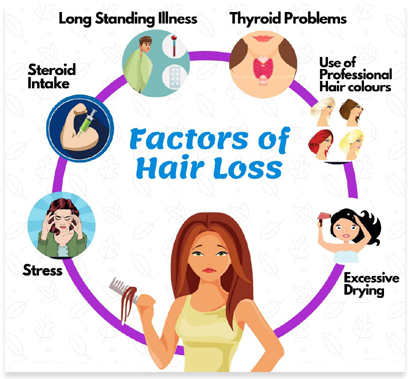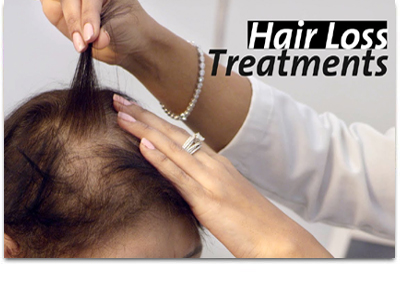Overview
 Hair loss, also called alopecia or baldness, refers to hair loss from the head or body. It can refer to general hair loss or male pattern hair loss.
Hair loss, also called alopecia or baldness, refers to hair loss from the head or body. It can refer to general hair loss or male pattern hair loss.
Female pattern baldness usually causes thinning throughout the scalp. It could also appear as if the area around the part is extended or thinning. In male pattern baldness, hair loss increases above the temples and thins toward the top of the head, forming the letter M.
Hair grows on human skin everywhere except the palms of our hands and soles of our feet, eyelids, and belly buttons. But a lot of the hair is so thin that it’s almost undetectable.
Hair loss is, in fact, a natural occurrence in your body. Old hair must leave the follicle as new hair grows.
Like leaves on trees, all hair passes through a natural cycle of growth, rest, and fall. People have between 100,000 and 150,000 hairs on their heads. The number of hair strands lost in a day varies, about 100 on average.
Some of the types of hair loss include :
- Circular or patchy bald spots: On the scalp, beard, and eyebrows, some people lose hair in circular or patchy bald areas. Before the hair falls out, your skin may become uncomfortable or unpleasant.
- Gradual thinning of the top of the head: It is the most common type of hair loss in older people.
- Sudden loosening of hair: Hair might become loose because of physical or emotional trauma. When combing or washing your hair, or even after light tugging, a few strands of hair may fall out. Hair thinning is common with this form of hair loss, although it is only temporary.
- Full-body hair loss: Some medical diseases and treatments, such as chemotherapy, can cause hair loss. Hair usually grows back.
- Androgenic alopecia: Hereditary hair loss, including male or female pattern baldness, is termed androgenic alopecia. It affects up to 50% of people and is the most prevalent cause of hair loss.
Symptoms
Signs and symptoms of hair loss may include:
- Circular or patchy bald spots: Some people lose hair in circular or patchy bald spots on the scalp, eyebrows, or beard. Your skin may become itchy or painful before the hair falls out.
- Full-body hair loss: Some conditions and medical treatments, such as chemotherapy for cancer, can result in hair loss all over your body. The hair usually grows back.
- Patches of scaling that spread over the scalp: This is a sign of ringworm. Symptoms include broken hair, redness, swelling, and, sometimes, oozing.
- Widening part: You might notice that your part is getting wider when you part your hair, which is a sign that your hair is thinning.
- Receding hairline: Similarly, if you notice your hair looking higher than usual, it can be a sign of thinning hair.
- If your hair is loose, check your brush or comb once you have used it. Is it collecting more hair than usual? If so, this may be a sign of hair loss.
- Bald patches: These can range in size and grow over time.
- Clogged drains: You might find that your washbasin or shower drains are plugged with hair.
Causes
 The first sign of hair loss is that people often notice more hair than usual left in the hairbrush after brushing or in the basin after shampooing.
The first sign of hair loss is that people often notice more hair than usual left in the hairbrush after brushing or in the basin after shampooing.Hair loss can appear in many ways, depending on the cause. It might strike unexpectedly or gradually, and it can affect your entire body or just your scalp.
Common causes of hair loss include:
- Age: Everyone experiences hair loss and thinning as they age. You also produce less oil on your scalp as you age, making your hair brittle and weak. It can also contribute to overall hair loss and thinning.
- Genetics: The most common cause of hair loss is a hereditary condition that happens with aging. This condition is called androgenic alopecia, male-pattern baldness, and female-pattern baldness.
- Hormonal changes: High levels of androgen are associated with polycystic ovary syndrome (PCOS) and congenital adrenal hyperplasia (CAH), which results in female-pattern hair loss. Pregnancy, childbirth, menopause, and hypothyroidism can dramatically alter hormone levels also.
- Stressful life events: Some people experience a general thinning of hair several months after a physical or emotional shock. This type of hair loss is temporary.
- Nutritional deficiencies: Nutritional deficiencies can sometimes cause hair loss. Low levels of iron, vitamin D, and zinc have been linked to excessive shedding and hair loss.
- Autoimmune disease: Autoimmune diseases can lead to hair loss when inflammation attacks healthy hair follicles.
- Medications: Certain drugs, those used to treat cancer, arthritis, depression, blood pressure problems, and gout, can cause hair loss.
- Hairstyles and treatments: An excessive hairstyle, such as cornrows or pigtails, can lead to traction alopecia, a type of hair loss.
- Chemotherapy and radiation: The hair may not grow back the same as it was before.
Lab Tests
- To diagnose any kind of symptoms.
- To find out how well our organs are working.
- It can monitor chronic health conditions and diseases and find out problems in their early stages.
To find out the cause of your Hair Loss following tests are done :
- Complete Blood Count
- Calcium
- Phosphorus
- Iron Test
- Ferritin
- Thyroid Tests
- DHEA (Dehydroepiandrosterone)
- Luteinizing hormone (LH)
- Follicle-Stimulating Hormone (FSH)
- Testosterone
Treatments
 Treatment options for hair loss are numerous, ranging from medication to hair transplants. These are:
Treatment options for hair loss are numerous, ranging from medication to hair transplants. These are:
Oral supplements
- Vitamin B12 (Cobalamin): Essential for red blood cell formation, which transports oxygen and nutrients throughout the body and to hair follicles as well.
- Vitamin B7 (Biotin): Stimulates hair keratin production and improves follicle growth.
- Zinc: It is an essential mineral that is involved in several biological processes in the body. Also required for the production of proteins in your hair and other tissues.
- Iron: The most effective way to treat hair loss with ferritin is to increase your iron levels. Supplements and foods containing iron can treat hair loss due to iron deficiency.
Platelet-rich plasma (PRP) therapy
PRP is a process that involves processing and injecting the patient’s blood into various locations on the scalp. PRP, which is rich in growth factors, helps in hair growth.
Hair transplantation
Hair transplantation involves extracting hair from a hair loss-resistant area and transplanting it to a backward part of the head. It can restore eyebrows, eyelashes, and beard hair, and fill in scars caused by accidents or surgery, such as facelifts or previous transplants. It is not a gender-specific procedure and thus helps treat both male and female baldness.
Laser therapy
The FDA has approved a device that uses light to treat genetic hair loss in both men and women. Studies have found that it improves hair density. More research is needed to demonstrate long-term effects.
There are a few things you can do to minimize hair loss:
- Keep hairstyles loose- Make sure you keep your braids, buns, or ponytails loose so they don’t put too much pressure on your hair.
- Avoid touching your hair- Don’t pull, twist, or rub your hair as much as possible.
- Hair dry- Use a towel to gently pat your hair dry after washing. Avoid rubbing your hair with a towel or twisting it in a towel.
- Aim for a nutrient-rich balanced diet- Eat plenty of iron- and protein-rich snacks and meals.
Styling products and tools are also common culprits of hair loss. Examples of products or tools that can cause hair loss include:
- Blowing dryers
- Heated combs
- Hair straighteners
- Coloring products
- Bleaching agents
- Perms
- Relaxers
You should only use heated tools on your hair when it is dry and in the lowest setting.

